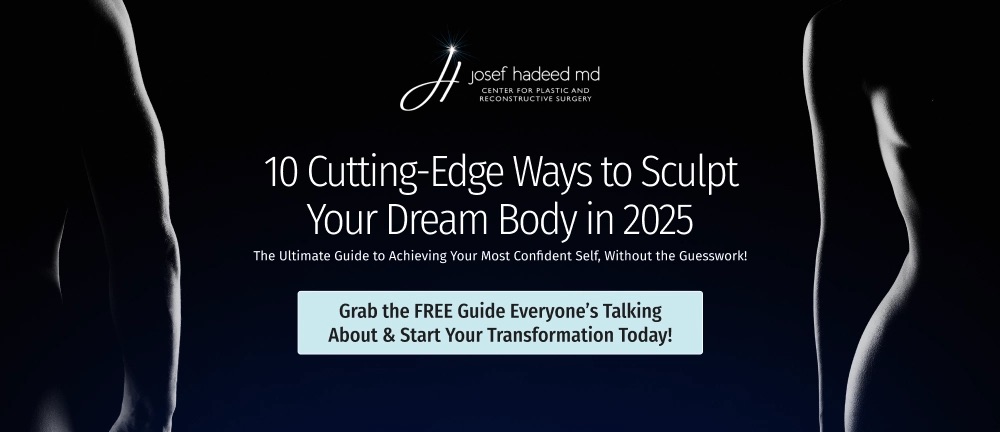Gynecomastia Self-Care
Posted July 16, 2025 in Services for Men by Josef Hadeed, MD

For many men, developing gynecomastia (often called “man boobs” or “moobs”) is more than just a physical issue. It can lead to feelings of self-consciousness, decreased confidence, and social anxiety, especially when it comes to wearing fitted shirts, going to the beach, or undressing in front of their partner. If you have gynecomastia, understanding what it is and how to treat it can make you feel like you’re taking steps to improve your appearance and restore a positive outlook.
In this blog, we’ll discuss what you need to know about gynecomastia and ways you can take charge of your condition.
10 Min Read:
Table of Contents
- Introduction to Gynecomastia
- Gynecomastia vs. Pseudogynecomastia: What’s the Difference?
- Understanding Breast Tissue
- Causes of Gynecomastia
- Can Gynecomastia Go Away on Its Own?
- Gynecomastia Self-Care Tips
- When to See a Doctor for Gynecomastia Treatment
- Learn More About Gynecomastia Surgery in Beverly Hills
Introduction to Gynecomastia
Gynecomastia is a medical condition where men develop enlarged breast tissue, usually caused by excess glandular tissue. This condition can be emotionally distressing for men, causing many to feel self-conscious about their appearance and experience emotional distress and low self-esteem.
The root cause of gynecomastia is typically a hormonal imbalance—specifically, an increase in estrogen production or a decrease in testosterone levels. These changes in hormone levels can trigger the development of glandular tissue, resulting in excess breast tissue.
To better manage gynecomastia and feel more confident in your body, it helps to understand what’s causing the issue and what treatment options are available.
Gynecomastia vs. Pseudogynecomastia: What’s the Difference?
If you’re dealing with enlarged breast tissue, the first step is figuring out whether it’s true gynecomastia or something called pseudogynecomastia. While they may look similar, the causes—and treatments—are different.
Gynecomastia is the enlargement of male breast tissue due to a hormonal imbalance, specifically, an increase in estrogen levels or a decrease in testosterone. This hormonal imbalance results in the growth of glandular breast tissue, which feels like a firm or rubbery button underneath your nipple. The development of breast fat in men can result in a more feminine contour of the chest, impacting body image. True gynecomastia often requires gynecomastia surgery, or male breast reduction surgery, to correct.
Pseudogynecomastia refers to the accumulation of fat in your chest without the presence of glandular tissue growth. Enlargement of breast tissue can cause the appearance of breasts in men. This form of male breast enlargement is often linked to weight gain and may improve with diet and exercise alone, though you may choose to treat gynecomastia with liposuction. Reducing overall body fat through a combination of diet and exercise can help reduce chest fat and improve the appearance of the chest. Losing fat across the entire body is important for reducing pseudogynecomastia, and strategies to reduce body fat and promote fat loss are key for managing this condition.
If you’re unsure which condition you have, a consultation with Dr. Hadeed can help clarify your diagnosis and provide guidance about options available to treat gynecomastia. He will conduct a physical examination, review your medical history, and provide recommendations for treatment.
Understanding Breast Tissue
In men, breast tissue is composed of both glandular tissue and fat. Gynecomastia occurs when there is an overgrowth of excess glandular tissue, often triggered by an imbalance of sex hormones such as estrogen and testosterone levels. This tissue is particularly sensitive to increases in estrogen, which can lead to the development of a firmer, more prominent chest area. Recognizing the difference between glandular tissue and fatty tissue is important, as it influences the most effective treatment approach—whether that involves gynecomastia surgery to remove the enlarged tissue or hormone therapy to address an underlying medical condition. A clear understanding of breast tissue composition helps guide the path to lasting results.
Causes of Gynecomastia
While an imbalance of hormones is the cause of gynecomastia, there are several reasons why your hormones may be off-kilter. Hormonal imbalances can affect men at various life stages, such as puberty and aging, leading to medical conditions like gynecomastia. The pituitary gland plays a key role in regulating hormone production, and resistance or dysfunction at this gland can impact testosterone production, contributing to gynecomastia. Common causes include:
- Natural Hormonal Changes: Puberty and middle age can cause fluctuations in testosterone and estrogen levels, and a large percentage of men and boys experience gynecomastia at some point in their lives. Gynecomastia is a prevalent condition, with 50–60% of adolescent boys and 65% of men between the ages of 27 and 92 developing this condition.
- Prescription Medications: Some medications, including anabolic steroids, anti-androgens, certain antidepressants, and medicines for ulcers or heart conditions, can contribute to the development of gynecomastia.
- Substance Use: The cause of gynecomastia has been associated with alcohol consumption, marijuana use, and taking certain medications such as opioids or anabolic steroids.
- Health Conditions: Liver disease, kidney failure, certain types of cancer, and hyperthyroidism may disrupt hormone levels.
- Obesity: Excess fat can lead to higher estrogen production, which can trigger the growth of glandular tissue.
Can Gynecomastia Go Away on Its Own?
In some cases, yes. Especially during puberty, gynecomastia often resolves without treatment as hormone levels stabilize. However, adult gynecomastia is less likely to resolve on its own, particularly if it’s been present for over a year or if it’s due to an ongoing medical issue, medication, or an underlying condition such as hormonal imbalances or tumors that require medical evaluation.
Still, for men with mild gynecomastia, lifestyle changes that lead to weight loss may help balance their hormones. Estrogen is produced in fatty tissue, so achieving a healthy weight can help balance hormones and alleviate gynecomastia. It is important to consult a doctor to determine the best treatment for your specific condition.
Gynecomastia Self-Care Tips
While gynecomastia may not go away without professional treatment, the following self-care strategies can help manage or alleviate symptoms, especially if you’re dealing with pseudogynecomastia or mild gynecomastia.
Diet Tips
A healthy diet is a key component in fat reduction and can help balance your hormones. Things to consider when choosing the foods you eat include:
- Reducing processed foods, including sugar, refined carbs, and trans fats
- Eating more fiber-rich foods like fruits, vegetables, and whole grains to help regulate insulin and support liver function, which is necessary for estrogen metabolism.
- Incorporating healthy fats in your diet by eating foods high in omega-3 fatty acids to help modulate hormone production.
- Avoiding excess phytoestrogens, which are typically soy-based foods that contain plant estrogens.
Losing weight by improving your diet can help reduce fat in your chest, minimizing the appearance of pseudogynecomastia.
Exercise Tips
Incorporating a great exercise routine is also an important part of self-care for gynecomastia. While you can’t “spot reduce” when it comes to losing weight, building muscle through targeted exercises can help sculpt your chest and improve your confidence. Fitness tips to consider include:
- Strength Training: Incorporating strength training with chest exercises, such as bench presses and push-ups, is effective for building chest muscles. These can be performed using your own body weight to help tone your pectoral muscles and support weight loss.
- Cardio Exercises: Cardio exercises, such as running, swimming, or high-intensity interval training (HIIT), can help you burn excess fat and lose weight.
- Consistency Is Key: Be consistent—aim for at least 150 minutes of moderate-intensity exercise each week, combined with two to three days of strength training.
Incorporating other exercises, such as sprints and lifting weights, can further support a reduction in excess body fat and an increase in muscle development. Combining strength training and cardiovascular exercises is key to improving your overall health and chest appearance.
While exercise alone can’t eliminate true gynecomastia, it can improve the contour of your chest and make the condition less noticeable.
Medical Tips
If you suspect your gynecomastia is linked to medications, hormone imbalances, or an underlying health condition, medical self-care is essential, including:
- Reviewing your medications and talking to your doctor about switching medications if your current prescriptions are known to cause increased breast tissue growth.
- Checking your hormone levels.
- Limiting alcohol and recreational drugs.
- Consulting your doctor before taking any supplements.
If self-care and medical management do not effectively address gynecomastia, surgical options may be considered to treat persistent gynecomastia. Always consult a qualified healthcare provider to determine the most appropriate approach for your individual needs.
When to See a Doctor for Gynecomastia Treatment
Self-care is always a good idea and an excellent starting point for dealing with gynecomastia. However, professional treatment may be necessary if:
- You’ve had symptoms for more than a year, and they haven’t improved with diet and exercise.
- Your breasts or nipples are painful, tender, swollen, or continuing to increase in size.
- You feel a hard lump under your nipple, which could require evaluation to rule out rare conditions like breast cancer.
- The condition is affecting your mental health, causing depression, lack of confidence, or social anxiety.
- You’ve been diagnosed with gynecomastia, and lifestyle changes haven’t helped the condition.
In these cases, a plastic surgeon, endocrinologist, or primary care physician can help you understand your options. Plastic surgery for gynecomastia often involves making small incisions around the areola or in natural chest creases to remove excess tissue and sculpt the chest for improved contour. Male breast reduction surgery performed by Dr. Hadeed includes liposuction, gland excision, or a combination of both. His gynecomastia surgical technique is highly effective for restoring a flatter, more masculine chest contour.
Learn More About Gynecomastia Surgery in Beverly Hills
Gynecomastia is more common than you think, and it’s nothing to be ashamed of. Whether your condition stems from hormonal changes, weight gain, medications, or other causes, gynecomastia surgery in Beverly Hills, CA, performed by board-certified plastic surgeon Dr. Josef Hadeed can help. Dr. Hadeed has extensive experience performing plastic surgery procedures, including gynecomastia surgery.
To learn more and discover if gynecomastia surgery is right for you, schedule a consultation with Dr. Hadeed today by calling (310) 970-2940 or request an appointment online.

